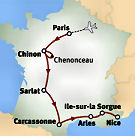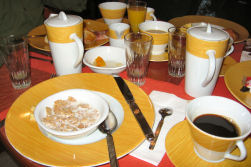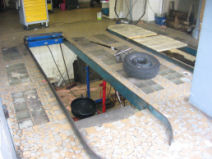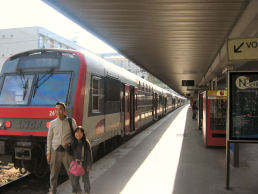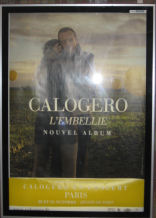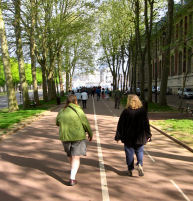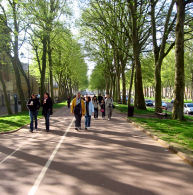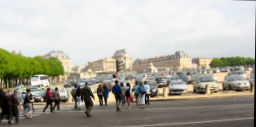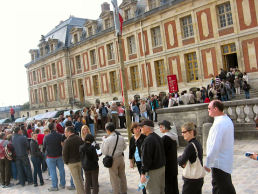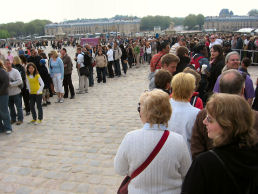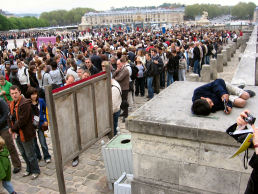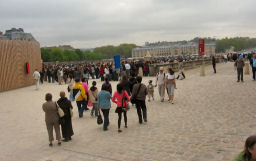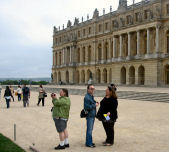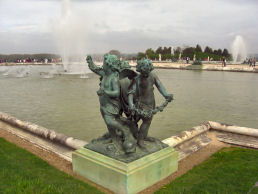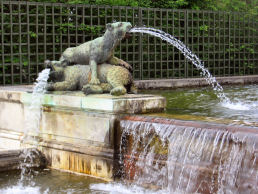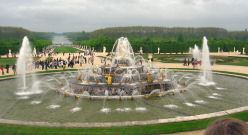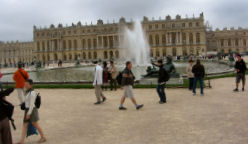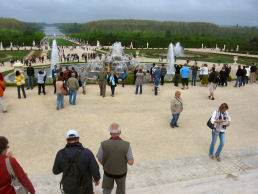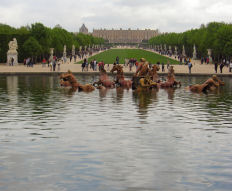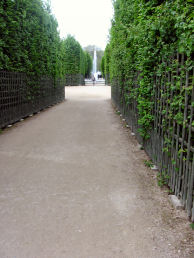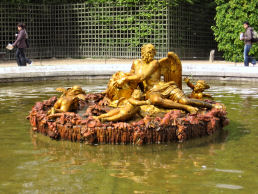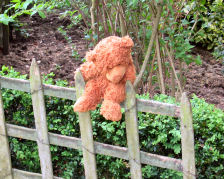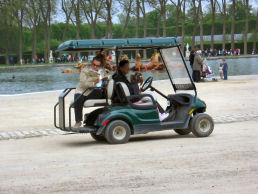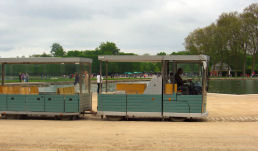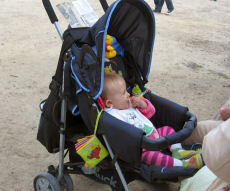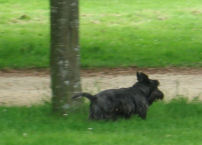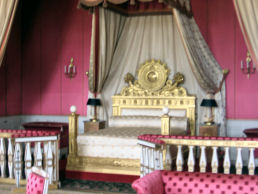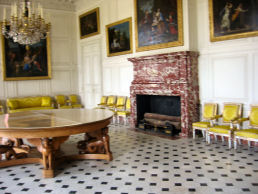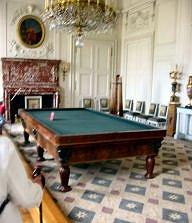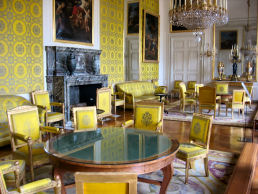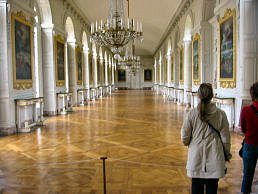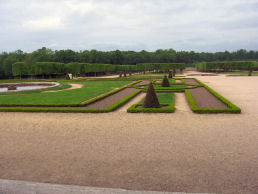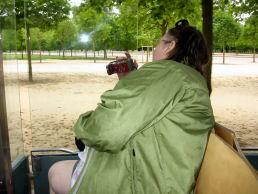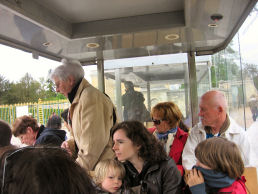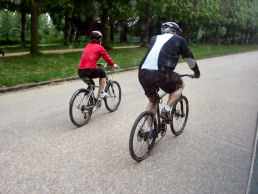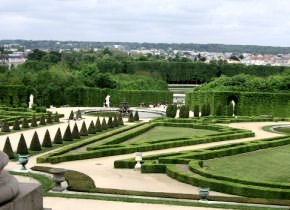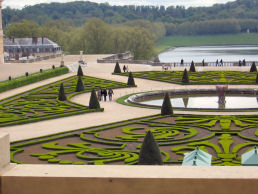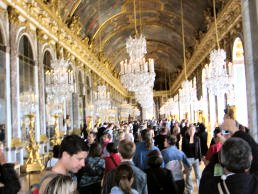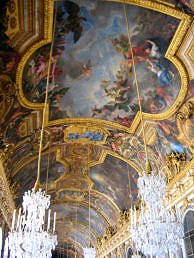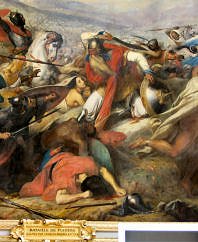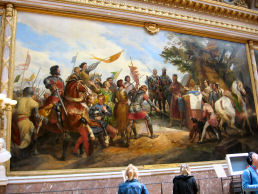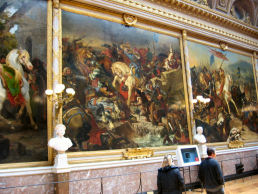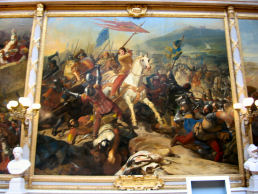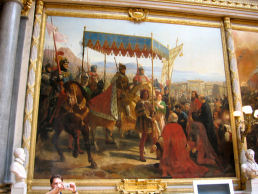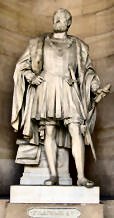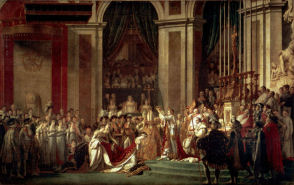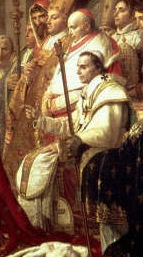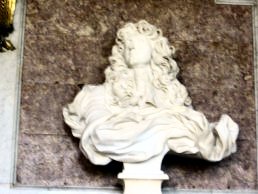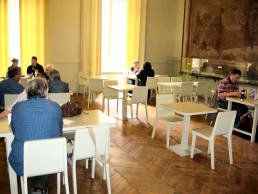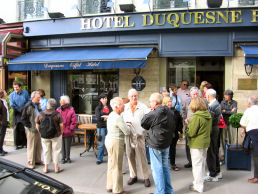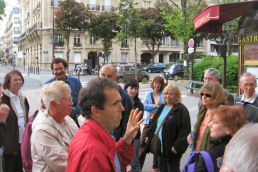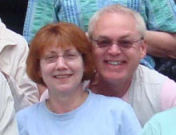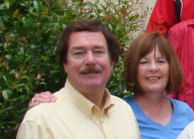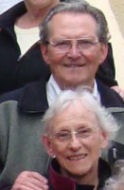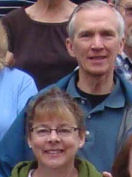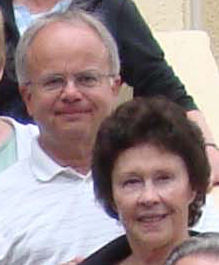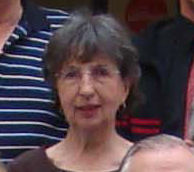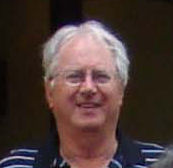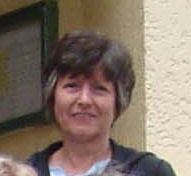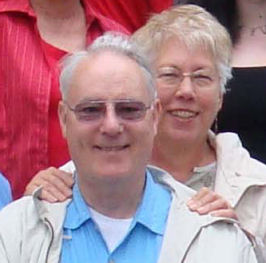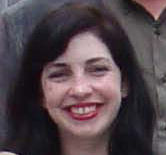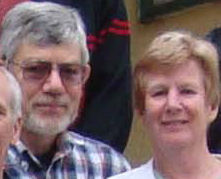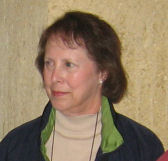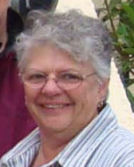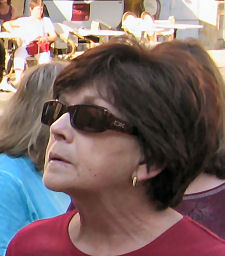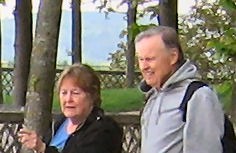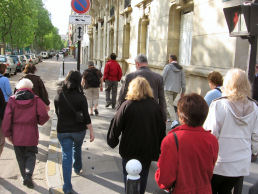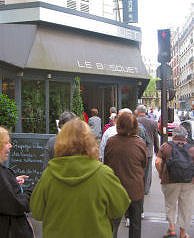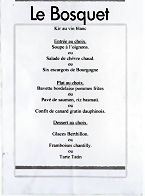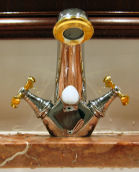I slept like a log. You can usually find me out searching for worms before the robins, but on this morning Tom and Patti had to wake us up at 7 a.m. I had to conclude that whenever I wore the eye mask while I was sleeping, we would have to ask for a wake-up call. This was something that I had almost never done in any of my travels.
We took a few minutes to revive ourselves, and then we joined the Corcorans at breakfast. I forgot my camera, but I would have several more chances to snap photos of the hotel’s breakfast area. As European breakfasts go, it was pretty good. The layout included Canadian bacon, scrambled eggs, cereal, milk, orange and apple juice, coffee, rolls, bread, yogurt, and cheese. The coffee, which one ordered from the ladies who were managing the place, was awful, the eggs were runny, and the bread was, like almost all bread in France, much too chewy for my taste. On the other hand, there was no problem at all finding enough tasty food to satisfy one’s belly. We needed to check out of the hotel and check back in as part of the tour group. We got to stay in the same room, but they gave us new key cards.The weather seemed to be pretty good. It was a little cool for my taste and overcast, but Sue would be dying if it were sunny and a little hotter.
Planned today was an unofficial day trip with the Corcorans to Versailles, which is southwest of Paris. On the way to the Métro station we walked up Avenue Duquesne, as usual. The avenue consisted of a wide two-way street in the middle with one-way lanes on both sides. The latter included places for parking. For the first time I noticed that on our side of the street among the parking spaces was an Elan gas station. It consisted of two unattended pumps in the very small area between the parking spots and the avenue and a storefront. On a subsequent day we saw that, in fact, the storefront also included a miniature garage with two stalls for working on cars.
To get to Versailles we needed to take the Métro to the Invalides stop. We then undertook a long hike through the station to the portion that served the RER trains. We had read in the guidebook that one could purchase tickets for the château and the garden of Versailles. This turned out to be incorrect. So we just purchased RER tickets for Versailles.We found the track and waited for the train labeled VICK. The ride was about thirty minutes. Since we were going to the end of the line, it was relatively stress-free. I noticed that a woman on the train had a copy of the Rick Steves Paris guidebook. We could not help but wonder if she was part of our group. This sort of sighting had happened to us on the day before tours before, and then as now it turned out not to mean anything.
Among the first things that caught our attention as we left the train station in Versailles were a McDonald’s and a Starbucks, which were strategically placed across the street from the train station in the direction of the château.The walk from the train station followed a lovely tree-lined boulevard. Determining which way to go was not difficult. We just followed the crowd. The first view of the château was stunning. I had read that this was one of the most impressive-looking buildings in Europe, but I was still overwhelmed. It had had this effect on people for over three hundred years.
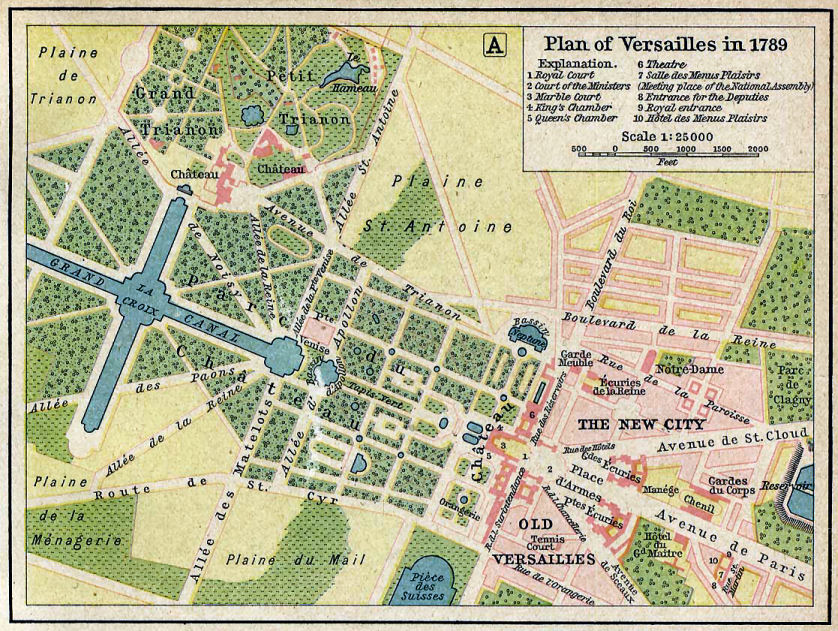
Two English women were in front of us. One laughed at my jokes, which is the shortest route into my heart. In front of them was a group that included a very plain woman with abnormally large hands, a lot of makeup, and an Adam’s apple. Behind us were an Italian couple. I overheard the signora mutter “Che cavolo!” at one point. In Italian that literally meant “What a cabbage!”, but cabbage was often used in Italian as a polite stand-in word for much more obscene concepts. When some people tried to “jump the queue,” the Italian lady lit into them. Sue later told me that the interlopers had usurped a spot in line a little behind the Italians.
Admission to the gardens, the Marie Antoinette section, and the château cost 22.50€, which was a pretty good deal as long as you actually visited all three. The selling of the tickets actually seemed pretty efficient. It was puzzling why the line seemed to move so slowly.Believe it or not, the line to get into the château was at least as long as the line to purchase tickets, and it did not appear to be moving much more quickly. Since the guidebook said that the lines were sometimes shorter in the afternoon, we decided to enter the gardens, for which there was no line to speak of, first. The initial view of the gardens was at least as stunning as the first view of the château. The estate literally went on as far as the eye could see. It was all laid out in precise geometric patterns and meticulously groomed. The fountains were even flowing. It was quite a sight.
The four of us ambled around snapping photos for a few minutes. Patti and Tom decided that they wanted to go at their own pace. We agreed to meet at the Grand Trianon, Louis XIV’s private residence, which was off to the right of the Grand Canal, at 12:15.Sue and I spent a bit of time leisurely exploring some of the gardens on the left side of the estate. It is hard to describe what these were like. We had a very enjoyable and relaxing time even if we were a little disappointed with the so-called Mirror Fountain and the Colonnade Grove. Our favorite part was probably the King’s Garden. Both of us took a lot of pictures there.
We thought that we had allowed enough time to make it to Grand Trianon in time. We tarried around the Apollo Fountain for a while. Then we headed toward the canal, and we did not dawdle. From there I miraculously selected the shortest diagonal route from the edge of the canal to Grand Trianon. However, we were still almost a half mile from the Grand Trianon, and that represented a long slog for Sue. Even though it was just a dirt road through the forest, it would have been a very pleasant place to stroll if we were not on a deadline. Occasionally we would sight some picnickers. Sue got a little tired, and her leg was bothering her. We had to take a couple of breaks. As a result we were about ten minutes late to Grande Trianon. We expected that Patti and Tom would know us well enough that they would be waiting for us. However, there was not much of a crowd there and we did not see our friends anywhere.
Sue agreed to sit outside of the Grand Trianon and stay on the lookout for the Corcorans while I went inside the building. It was luxurious of course, but nothing really struck my fancy. I also took a peak at the massive garden behind the building. I did not spend a great deal of time there, because I wanted to find out whether we had missed the Corcorans.
When I exited the Grand Trianon, I had no difficulty locating Sue. She told me that she had not seen the Corcorans. We decided to take the little train back to the château. It went down to the Petit Trianon, and then it chugged over to the Grand Canal. Its last stop was just outside of the château. By the time that we had said good-bye to the train and walked around the side off the building it was 1:30.
The line to enter the château was a little shorter than it had been in the morning, but it still stretched across the square, all the way down to the entrance and almost all the way back. Sue had no interest in standing in it, but I almost never give up on doing something that I have already paid for. We agreed to meet at 3:30 by the toilets near the bookstore. The Grand Café d’Orlèans was located in the same area, so Sue would be able to get some refreshment if she wanted. We figured that we would have just about enough time to get back to the hotel in time for the meeting with the rest of our tour group that was scheduled for five p.m. I got in line for the château. The couple in front of me took photos of one another every few minutes. Two Italian girls stood behind me. I tried to listen in on their conversation surreptitiously, but most of the time they spoke so softly that I would have had to stick my head between them to understand them. I was not about to do that; one of them smoked.
After forty-five minutes just as I was approaching the entrance, a strange thing happened. On the château side of the line a group that seemed to include a lot of Chinese people assembled right next to us. Simultaneously a much smaller group of people formed on the other side. In short order, the line began to resemble a mob. I could not tell for sure how many people jumped the line. The chaos made it impossible. The important thing was that I managed to get into the château within a minute or two.
I tried to use the self-guided tour in the Paris guidebook, but I was not sure where I was starting. The layout in the book did not seem to match the configuration that they were using that day.
My favorite place was probably the Hall of Battles. I was familiar with quite a few of the kings and generals in the paintings. It was interesting to see the depiction of Charles VIII’s triumph in Naples and Francis I’s victory at Marignano. King Charles was driven out of Italy shortly thereafter with his tail between his legs, and King Francis was taken prisoner. I wondered how many of the other French triumphs were equally illusory.
I spent quite a bit of time unsuccessfully trying to photograph David’s massive painting of Napoleon’s coronation of Josephine. The room in which it was located seemed to be the only one in the entire château that was poorly lit. I wasn’t trying to get the whole thing. I just wanted to capture the look on Pope Pius VII’s face, but all of my attempts were futile. I could not hold the camera steady enough. Maybe I will learn how to use my camera before I die.The pope was sixty-four at the time of Napoleon’s coronation, but he looks much younger in both this painting and David’s portrait of him with Cardinal Caprara, executed the next year.
The hall of mirrors was also quite impressive, but I, unlike the seventeenth century guests, had actually seen a mirror before. I got a pretty good photo of Bernini’s statue of Louis XIV. That guy had flair. Or better: those guys had flair. I actually had some time to spare after I visited the château. I went to the not-so-grand part of the café, in which one is required to serve oneself. I did not get anything, but I found a spot to sit at a table in a room reserved for people who did. It did not seem to be very crowded, and no one hassled me about it for the fifteen minutes that I was there resting my dogs.I easily found Sue. She told me that she had been at the café and had ordered a cake and some tea. At first the waiter told her that she could not have dessert without ordering a meal, but he promptly delivered her tea. When she later asked about the cake, he was surprised that they had not brought it. He went back and checked. Evidently the restaurant had run out of the cake, and no one had bothered to tell her.
We made our way down to the train station and quickly found our train. The one that we boarded was almost empty, so one must have just departed. Ours filled up rather quickly, and in a few minutes it started moving. We arrived back to the hotel with just enough time for me to shower and dress for the five p.m. meeting in the breakfast room in the basement. I put on the black shoes. This might be my only chance to wear them on the tour.
I took the stairs; Sue waited for the elevator. When I arrived in the breakfast room, our tour guide, Patrick Vidal, greeted me with a hearty “Bonjour, monsieur.” I replied “Bonsoir,” which might have thrown him a little. He offered a choice of a cup of red wine or white. The room was already pretty full. Only one or two tables had any seats left. I sat next to Phoebe Liddle. Sue took the place next to Phoebe’s husband, Tom. Nancy Kress came a minute later and sat on my left. Barbara Postles took the bar stool. The Corcorans took the last two seats.
Patrick was from Brittany, the northwest corner of France that Rick Steves cuts off of his maps. Patrick’s English was as good as it was because, he said, he was married to a Brit. Before becoming a tour guide he had been a bus driver. He said that at the time of his birth Patrick was a popular name for male children in France and that Vidal was actually a Spanish name. It was a disappointment, of course, that he could not be named Jean-Claude Robespierre or something like that, but we resolved to deal with it.Patrick cycled through the usual details of how a Rick Steves tour worked. He also outlined the agenda for the next few days. On Sunday we would go to the Île de la Cité as a group to see Sainte-Chapelle and Notre Dame. We would eat lunch on our own and then go to the Musée d’Orsay as a group. Once in the museum we would again be on our own for the rest of the day. Monday would feature a guided tour of the Louvre in the morning and a free afternoon and evening. In short, we would only have one meal together in Paris, and it would be right after the meeting.
Patrick mentioned that BNP Paribas ATM’s could be used for free by Bank of America customers. He also noted that there was one right down the street from the hotel. We had not yet located it. He also gave two excellent pieces of advice for traveling in France: (1) tipping is optional; (2) use “carafe d’eau” to ask for tap water, which is uniformly potable in France, in restaurants.
Patrick asked each of us to introduce ourselves. A formidable challenge on each tour has been keeping the cast of characters straight. I took notes as carefully as I could, but I might have missed some details.
Loraine Stan introduced herself and her husband Tom, neither of whom had been on a Rick Steves tour before. They evidently lived in Akron, but Tom worked in Dayton, which, by my calculation, was close to two hundred miles away. This arrangement certainly sounded peculiar, but Loraine said that she liked it that way because she did not have to cook for him. I definitely did not get the impression that she was joking.Jim and Barbara Foley were from some place in Colorado. This was their first tour as well.
Roscoe and Gigi Carnahan hailed from Linwood, WA. Gigi originally came from Belgium and spoke French fluently. They had traveled extensively. In fact, they had just finished the Paris and the Heart of France tour.Brad Colwell said that he and his wife Donna were from Harrisburg, PA. Brad was a marathoner and a vegetarian. This was their first tour. Brad said that he had chosen the tour because the write-up said that it was strenuous. That statement elicited a reaction.
Six Canadians were traveling together. I think that they said that they had taken tours of Italy and Greece together. Dave and Mary Colley and Roy and Betty Coffin were from Vancouver. Len[1] and Georgene Dunlap were from White Rock, BC.
Mike and Sandy Birdlebough hailed from Prosser, WA, on the dry side of the state. They had also taken the tour of Greece.
Jacqueline Jensen was the youngest person in the group by at least one generation. I wrote down that she worked in a hospital in the Seattle area. She had not previously been on a tour. One of the reasons that she chose the tour was to investigate her French ancestry.
Tom and Patti introduced themselves. Patti said that they were traveling with a couple that had not yet shown up at the soirée. It was a dirty damned lie. We were within ten feet of them, and we arrived at the meeting before they did.
Paul and Kathy Lantz were from Seattle. They had taken seven tours.
Barbara Postles was traveling with Nancy Kress. Nancy, from Rochester, NY, had taken eight tours, and Barbara, from Columbia, SC, had also traveled quite a bit. I think that Barbara said that they were cousins.
Diane Cira had done the Spain and Portugal tour. I did not hear where she was from. She was traveling with Lee Wurlitzer, who was from Burlingame, CA.
Tom and Phoebe Liddle were from Bethesda, MD. They did not mention any previous tours.
The group included three Toms, two Mikes, and two Barbaras.
When the meeting had ended, the group followed Patrick over to the Rue Cler district, which, he explained, Rick Steves had put on the map. It certainly seemed to be an interesting place. It had numerous restaurants, but it did not seem to cater to tourists. At least I did not see anyone hawking replicas of the Eiffel Tower or running a three-card Monte game. Our restaurant, Le Bosquet, was not actually on Rue Cler, but it was nearby.Most of the group sat in the upper half of the restaurant. Sue and I were seated at one of the two tables in the lower half with the Coffins, the Corcorans, Jacqueline, and Patrick. I sat between Roy Coffin and Sue. Patrick was across from me.
Here was the menu[2] at Le Bosquet:- Apéritif: kir with white wine;
Entrée: onion soup, salad with goat cheese, or escargots; - Main course: flank steak with fries, salmon with rice, or duck with potatoes;
- Dessert: ice cream, raspberries with whipped cream, or apple tart with whipped cream.
I selected the escargots, salmon, and apple tart. They were all very good indeed. The escargots were the best that I had ever tasted. I would not have minded returning to this restaurant.
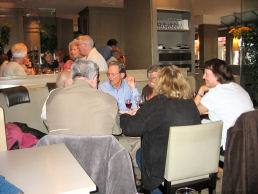
Roy and Betty Coffin were from Vancouver. Roy had worked with Len and Dave there for many years. The three couples went as a group on a Rick Steves tour to Greece. Betty said that her favorite foreign destination was Africa. Roy preferred Italy. Roy, Len, and Dave played golf together once a week. Betty preferred tennis.
Roy was fighting a cold. It did not seem ominous at the time.
During supper Barbara Postles rushed over to Patrick and asked him, “Am I an H or an F?” She had just visited the restaurant’s toilets. One was labeled H, the other F.
Patrick made sure that he was served last. He took whatever they served him so that if there was a mistake in any order (there was not), everyone in the tour received what he/she ordered. We could have used him the previous evening at the Café Constant.
On the way home I noticed that one of my shoes felt funny.
As soon as we returned to the hotel I went to bed. Because I had almost overslept the previous morning I decided not to wear my eye mask. I tossed and turned for a few minutes, but then I fell asleep quickly enough. As usual, Sue was still up and about when the sandman appeared.
